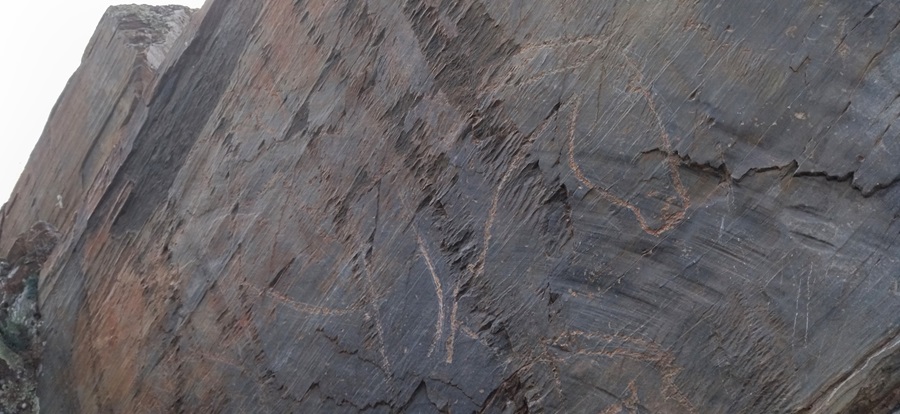- Science
- 13 de May de 2024
- No Comment
- 7 minutes read
Paleolithic Art Emerges from the Caves

Paleolithic Art Emerges from the Caves
The quality and quantity of the representations give Foz Côa and Siega Verde an entity perfectly comparable to that of the great Franco-Cantabrian caves


Manuel Santonja
Paleolithic cave art constitutes one of the most suggestive and unfathomable phenomena of humanity’s remote past. The discovery of its existence outside of caves was the great novelty of European Paleolithic archaeology in the last quarter of the 20th century.
The discovery in 1879 of the Altamira Cave, which continues to be one of the most spectacular sets known, took time to be accepted. Prehistory was then taking its first steps in France, and for those illustrious pioneers, it was difficult to accept that such perfect artistic manifestations could be the work of primitive beings. Something as spectacular could not be accepted as a past work when the linear evolutionist debate permeated the new discipline.
Although figures of animals engraved on bone instruments had been accepted as undoubtedly Paleolithic for decades, only the recognition in France of caves with paintings and engravings allowed, at the end of the century, to reach a consensus on the antiquity of the art represented in Altamira. The publication in 1901 by a young abbot Breuil of the paintings and engravings of Combarelles and Font de Gaume paved the way for the full acceptance of the expressive capacity of Homo sapiens from its earliest European times, invalidating the radical transformism that permeated the prehistoric paradigm in the 19th century. Throughout the 20th century, the number of caves with Paleolithic art would not cease to increase, especially in the regions of southern France and the Cantabrian coast of the Iberian Peninsula.

In the early 1980s, panels began to be identified outdoors with figures engraved entirely similar to those in the caves, and the hypotheses based on accepting as substantial the location of these representations in the troglodyte darkness weaken. Although they were already known at their entrances or in shallow shelters where daylight reaches, in the interpretations of the researchers, Quaternary art was valued as a hidden expression. The frequently difficult access significantly influenced the hypotheses that related it to the propitiatory magic of hunting or fertility, even with totemism and the performance of initiation practices in the most hidden sets.
Several of the first admitted exterior panels were located, like Altamira, in the Iberian Peninsula. Piedras Blancas in Almería, Domingo García in Segovia, and Mazouco in Portugal, on the banks of the Duero River, in the stretch that forms a border with Spain. These were isolated units, but shortly after, in 1988 and 1994, the first extensive sets like Siega Verde in Salamanca and Foz Côa in Portugal, appeared in the common region to both countries in which the Duero river network is deeply embedded.
The Salamanca station is located on the left bank of the Águeda river, occupying almost 1 km of its course in the terms of Villar de Argañán and Villar de la Yegua. Around a hundred panels have been described that house almost half a thousand engravings, including animals and non-figurative schemes of a symbolic nature, which repeat the conventions of representation documented in the caves. Among the first ones, half of them represent horses and a quarter aurochs. In smaller numbers deer and goats, as well as some carnivore, even a possible anthropomorph. The Foz Côa complex is made up of about 90 locations spread over the last 15 kilometres of this river’s valley, with a total set of more than 1,300 panels described, although none of them reach the dimension of Siega Verde.


The quality and quantity of the representations give Foz Côa and Siega Verde an entity perfectly comparable to that of the great Franco-Cantabrian caves, justifying the inscription of the Portuguese complex on the UNESCO World Heritage list at the end of 1999, extended in August 2010 to Siega Verde. Currently, the number of open-air sites with Paleolithic rock art in the Iberian Peninsula has increased considerably, and although the concentration in the valleys of the tributaries of the Duero continues to stand out, other notable locations have been made throughout the interior of the peninsula, in the river basins of the Tajo and the Guadiana.
In short, the discovery of sets located entirely outside has determined a profound change in the perception of this artistic universe. It sheds the mysterious halo that dominated it and is better connected with the daily activities of the groups of hunter-gatherers who executed it in the Upper Paleolithic. We will probably never get to know concrete meanings, but the manifestations in broad daylight refer to scenarios comparable to those of current primitive societies, whose polysemic artistic expression provides the most appropriate comparative terms.
References:
About the current state of research in Siega Verde and Côa: https://www.cenieh.es/sites/default/files/congress/files/ActualidaddelainvestigacionenlasestacionespaleoliticasdeSiegaVerdeyelvalledelCoa.pdf
Information to visit the sites:
Source: educational EVIDENCE
Rights: Creative Commons

